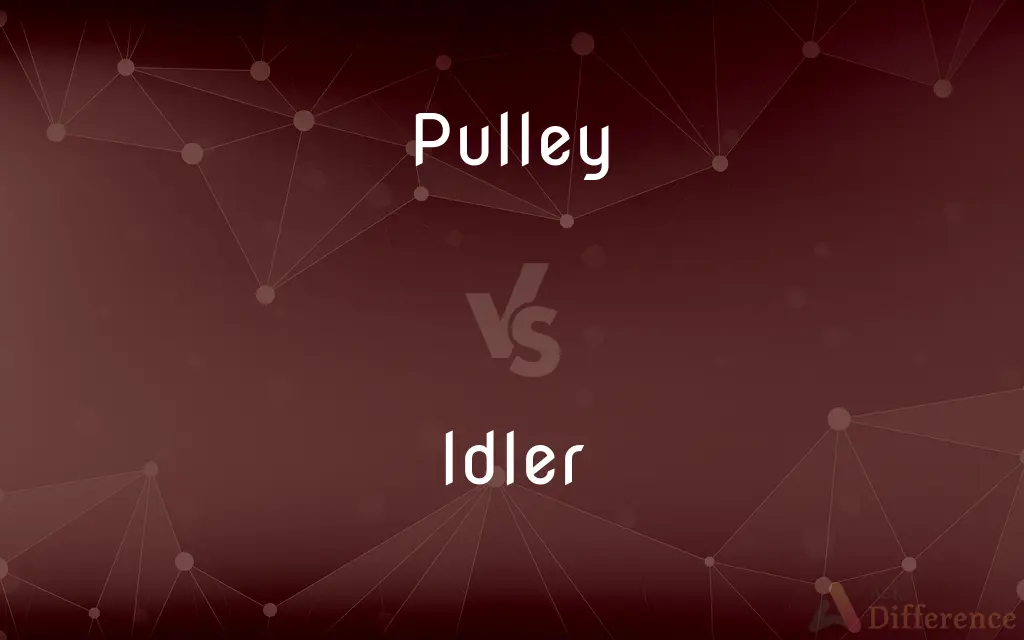Pulley vs. Idler — What's the Difference?
By Fiza Rafique & Urooj Arif — Updated on April 1, 2024
A pulley is a wheel on an axle designed to support the movement and change the direction of a cable or belt, while an idler is a specific type of pulley used to maintain tension or guide a belt in a transmission system without transmitting power.

Difference Between Pulley and Idler
Table of Contents
ADVERTISEMENT
Key Differences
Pulleys are simple machines consisting of a wheel on an axle or shaft, designed to support movement and change the direction of force in a cable or belt. They can be used individually or configured in systems to reduce the amount of force needed to lift heavy loads, through mechanical advantage. Idlers, on the other hand, refer to pulleys that do not transmit power themselves but are used to guide or tension a belt or chain in machinery. An idler pulley's primary function is to maintain the proper tension on a belt or to change its path, such as in conveyor systems, automotive engines, or in belt-driven machinery.
While all idlers are pulleys, not all pulleys are idlers. The distinguishing feature of an idler lies in its role in a mechanical system; it does not directly contribute to the power transmission but plays a critical support role. Idler pulleys can be adjusted or moved to maintain the correct tension on a belt as it stretches or wears over time.
The selection between a pulley and an idler depends on the specific needs of a mechanical system. Pulleys are chosen based on their ability to provide mechanical advantage and change the direction of force, while idlers are selected for their capacity to maintain system efficiency by guiding and tensioning belts or chains. Both play crucial roles in the functionality and longevity of mechanical systems, highlighting the importance of understanding their distinct functions despite their similar appearances.
Pulleys and idlers are manufactured from a variety of materials, including metals, plastics, and ceramics, depending on their specific application requirements. This choice is influenced by factors such as load, speed of operation, environmental conditions, and the nature of the belt or cable they interact with.
While pulleys are fundamental in creating and manipulating mechanical advantage, idlers are specialized pulleys designed to support the operational integrity of belt and chain systems through tensioning and guidance, underscoring the interplay between force transmission and mechanical support in complex systems.
ADVERTISEMENT
Comparison Chart
Definition
Wheel on an axle for changing direction or force
Type of pulley that guides or tensions a belt without transmitting power
Primary Function
Change direction of force, reduce effort needed
Maintain tension, guide belts or chains
Power Transmission
Directly involved in transmitting power
Does not transmit power
Application Examples
Lifting devices, construction cranes, sailing ships
Conveyor belts, automotive engines, belt-driven machinery
Role in Mechanical Systems
Provide mechanical advantage, efficiency
Support optimal functioning, prevent slippage
Compare with Definitions
Pulley
A simple machine that helps lift or move loads with reduced effort.
The construction crane uses a pulley system to lift heavy materials to the top floors.
Idler
Does not transmit power but supports belt systems.
The idler in the car's serpentine belt system maintains proper tension across all accessories.
Pulley
Can be part of compound systems for greater mechanical advantage.
The block and tackle system combines multiple pulleys to make lifting easier.
Idler
A pulley used to guide or adjust tension in a belt or chain.
The idler pulley in the conveyor belt system ensures the belt remains taut and in place.
Pulley
Used to change the direction of a force applied.
Sailors use pulleys to adjust the sails against the wind efficiently.
Idler
Can be adjusted to control belt tension.
Adjusting the position of the idler pulley can prevent the drive belt from slipping.
Pulley
Essential in various machinery for power transmission.
The pulley on the engine drives the belt that operates the alternator.
Idler
Helps in distributing wear evenly on belts and chains.
Regularly moving the idler pulley can extend the life of the conveyor belt.
Pulley
Can operate with belts, ropes, or cables.
The gym's weightlifting machine utilizes a series of pulleys to guide and adjust the weight resistance.
Idler
Often found in belt-driven machinery to support operational efficiency.
The printer's paper feed mechanism uses an idler pulley to ensure smooth paper movement.
Pulley
A pulley is a wheel on an axle or shaft that is designed to support movement and change of direction of a taut cable or belt, or transfer of power between the shaft and cable or belt. In the case of a pulley supported by a frame or shell that does not transfer power to a shaft, but is used to guide the cable or exert a force, the supporting shell is called a block, and the pulley may be called a sheave.
Idler
A person who avoids work or spends time in an aimless or lazy way.
Pulley
A wheel with a grooved rim around which a cord passes, which acts to change the direction of a force applied to the cord and is used to raise heavy weights.
Idler
A pulley that transmits no power but guides or stretches a belt or rope.
Pulley
Hoist with a pulley
The tree house was built on the ground and pulleyed into the branches
Idler
Not employed or busy
Idle carpenters.
Pulley
A simple machine consisting essentially of a wheel with a grooved rim in which a pulled rope or chain can run to change the direction of the pull, for example to lift a load.
Idler
Disinclined to work or be active; lazy
“a man who could seem idle, ignorant, even incompetent, yet was able to understand and to express ... the instincts, good and bad, of the American majority” (Godfrey Hodgson).
Pulley
A wheel turned by or driving a belt.
Idler
Not in use or operation
Idle hands.
Idle mills.
Pulley
One of the simple machines; a sheave, a wheel with a grooved rim, in which a pulled rope or chain lifts an object (more useful when two or more pulleys are used together, as in a block and tackle arrangement, such that a small force moving through a greater distance can exert a larger force through a smaller distance).
Idler
(Sports) Not scheduled to play a game
Both teams played today but will be idle tomorrow.
Pulley
(transitive) To raise or lift by means of a pulley.
Idler
Being a period of time in which there is little or no activity
Passed idle hours watching TV.
Pulley
A wheel with a broad rim, or grooved rim, for transmitting power from, or imparting power to, the different parts of machinery, or for changing the direction of motion, by means of a belt, cord, rope, or chain.
Idler
Lacking substance, value, or basis
Idle speculation.
Idle threats.
Pulley
To raise or lift by means of a pulley.
Idler
To pass time without being engaged in purposeful activity
“The girls idled all day long, sending their tinkling laughter flowing up and down the street” (Alai).
Pulley
A simple machine consisting of a wheel with a groove in which a rope can run to change the direction or point of application of a force applied to the rope
Idler
To move slowly or without purpose
“I drove past the workshop ... I idled along the driveway past the pole fence ... to Tyhee Road” (Tom Spanbauer).
Idler
To run at a slow speed or out of gear. Used of a motor or motor vehicle.
Idler
To pass (time) without doing anything
Idle the afternoon away.
Idler
To make or cause to be unemployed or inactive
Layoffs that idled 1,000 factory workers.
A plant that was idled by a strike.
Idler
To cause (a motor, for example) to idle.
Idler
A state of idling. Used of a motor vehicle
An engine running quietly at idle.
Idler
A mechanism for regulating the speed at which an engine runs at rest
Set the idle higher to keep the motor from stalling.
Idler
One who idles; one who spends his or her time in inaction.
Idler
One who idles; a lazy person; a sluggard.
Idler
Any member of a ship's crew who is not required to keep the night-watch
Idler
A mechanical device such as a pulley or wheel that does not transmit power, but supports a moving belt etc.
Idler
One who idles; one who spends his time in inaction; a lazy person; a sluggard.
Idler
One who has constant day duties on board ship, and keeps no regular watch.
Idler
An idle wheel or pulley. See under Idle.
Idler
Person who does no work;
A lazy bum
Common Curiosities
Why are idler pulleys necessary in belt systems?
Idler pulleys are essential for maintaining proper tension in a belt system, preventing slippage, and guiding the belt, ensuring smooth and efficient operation.
What happens if an idler pulley fails?
Failure of an idler pulley can lead to belt slippage, misalignment, or even breakage, resulting in system malfunction or downtime.
Are idler pulleys replaceable?
Yes, idler pulleys are replaceable components, and regular maintenance may involve replacing worn or damaged idlers to ensure system integrity.
Can the function of a pulley change in a system?
While a pulley's basic function remains constant, its role can vary depending on its position and usage within different systems, acting as a driver, follower, or idler.
Do all mechanical systems use idlers?
Not all, but many mechanical systems, especially those relying on belt or chain transmission, use idlers for tensioning and guiding purposes.
Can a system have multiple idlers and pulleys?
Yes, many systems use a combination of multiple pulleys and idlers to achieve desired mechanical advantages and maintain optimal belt or chain tension.
How do you choose the right pulley for a system?
The choice depends on the system's requirements, including load, direction of force, and whether mechanical advantage is needed. Material and size also play significant roles.
How does the use of pulleys impact energy efficiency?
Pulleys can significantly increase energy efficiency by reducing the amount of force required to move or lift loads, thereby saving on input energy.
What materials are used to make pulleys and idlers?
They can be made from metals, plastics, or ceramics, chosen based on factors like strength, durability, frictional properties, and environmental conditions.
How does mechanical advantage work in a pulley system?
Mechanical advantage in a pulley system allows a small force applied over a greater distance to move a larger load over a shorter distance, effectively reducing the effort needed.
Share Your Discovery

Previous Comparison
Principality vs. Archangel
Next Comparison
Principle vs. FeatureAuthor Spotlight
Written by
Fiza RafiqueFiza Rafique is a skilled content writer at AskDifference.com, where she meticulously refines and enhances written pieces. Drawing from her vast editorial expertise, Fiza ensures clarity, accuracy, and precision in every article. Passionate about language, she continually seeks to elevate the quality of content for readers worldwide.
Co-written by
Urooj ArifUrooj is a skilled content writer at Ask Difference, known for her exceptional ability to simplify complex topics into engaging and informative content. With a passion for research and a flair for clear, concise writing, she consistently delivers articles that resonate with our diverse audience.















































